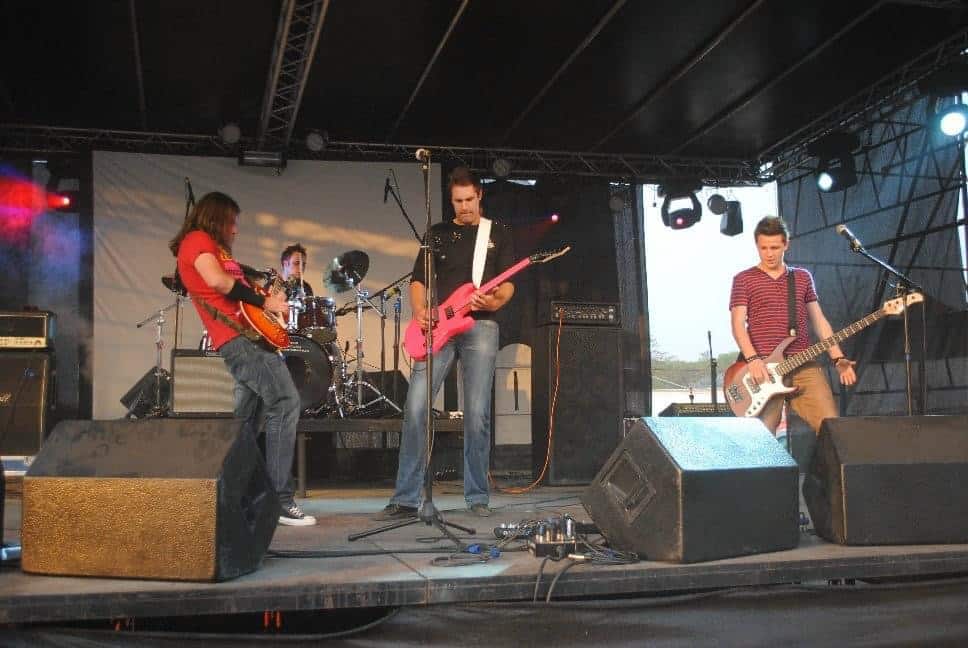If you would like to know the different types of names, instruments and positions each size of music band is called, you are at the right place.
In this guide, we’ll take a look at all the different sizes of bands plus some key information about the various instruments that usually take part in these bands.
If you are looking to start your band, you would surely be interested in my MEGA Starting a Band Checklist.
We’ll start with a three-piece band since I already wrote an article to cover you for a solo artist or a duo that you can find under Amount of People Needed for a Band Plus Tips.
The Three-Piece Band
A trio is the correct musical term we use to describe a musical act where three people are involved in delivering a performance. It’s also often called a three-piece band which is popular for variations of rock, street busking, jazz, and blues.
Instruments Involved
A trio rock band usually has drums, bass guitar, and a lead singer that plays the guitar. It is normal to add another mic to the drummer or bassist to provide more depth in the music in the form of a backup vocal.
Positioning On Stage
The members will position themselves in a triangle on stage. The drummer will take the back end, and the bassist and guitarist will complete the triangle in front of the drummer.
There’s no rule as to whether the bassist takes the left or right side of the stage, as long as they can connect well to the drummer and guitarist.
Examples of Famous Three-Piece Bands
- Blink 182 – Drums, Bass/Vocals, Guitar/Vocals
- The Jimi Hendrix Experience – Bass/Vocals, Drums, Guitar/Vocals
- Nirvana – Bass, Drums, Guitar/Vocals
The Four-Piece Band
A quartet is the correct musical term we use to describe a musical act where four people are involved in delivering a performance. This is the most popular version for a rock band since you can add another guitarist and more depth with the vocals.
Instruments Involved
A quartet rock band or a four-piece band usually chooses the have drums, bass guitar, a lead guitarist and a rhythm guitarist. The singing duties are often shared between the members with the rhythm guitarist the likeliest to be the lead singer.
Positioning On Stage
A quartet rock band positions itself with the drummer at the back side, the frontman or lead singer in front of the drummer, and the bassist and lead guitarist on the wings.
It is often the case that both wings get a microphone to support singing the backup vocals.
This post was written and posted by De Wet from startingmyband.com on 24.07.2023. The content was stolen from me if this blog post is seen anywhere else.

There are plenty of pros and cons when you play in a band. If you would like to know all about my version, read my article The Pros and Cons of Playing in a Band.
Examples of Famous Quartet Bands
- Green day – Vocals/Guitar, Drums, Bass, Guitar
- REM – Vocals, Guitar, Bass, Drums
- Metallica – Vocals/Guitar, Drums, Bass, Guitar
The Five-Piece Band
A quintet is the correct musical term we use to describe a musical act where five people are involved in delivering a performance.
Instruments Involved
A quintet usually has enough space for the artists to practice their instruments with freedom in terms of speciality. There’s less focus placed on the vocals to fill the sound and more space to fill the songs with various instruments.
The main instruments involved are drums, bass, rhythm guitar, lead guitar and vocals. You’ll often find that bands also include instruments like trumpets, keyboards and turn tables to bring in an alternative and unique sound.
Positioning On Stage
The drummer will be placed at the back of the stage with the frontman in front of him. The backup vocalist and an alternative instrument that needs a stable setup space will be on the wings, and the bassist will fill the space between the band with a special connection to the drummer.

Examples of Famous Five-Piece Bands
- Iron Maiden
- Aerosmith
- Oasis
The Six-Piece Band
A sextet is the correct musical term we use to describe a musical act where six people are involved in delivering a musical performance.
Instruments Involved
There’s an opportunity here to be creative in creating a new and unique sound. If you have the committed members to pull this off, try to think outside of the box and use instruments that will make your sound so unique that people will never forget you.
The advantage of having so many members is that you never have to worry about not having an audience. If each member brings 5 people, you’ll almost always perform in front of 30 people!
This band below where I played in for a few months was a sextet. We had a lead guitarist, 2 rhythm guitarists who focused heavily on harmonising, a drummer, and 2 bassists who also switched to bagpipes during certain parts of the set.

Positioning On Stage
The drummer will need to share some space at the back, usually with the bassist, otherwise with the lead guitarist or keyboard player.
Place your lead vocalist and backup vocalist next to each other at the front of the stage.
The position on the wings will be shared between the two remaining musicians which usually includes your lead guitarist.

Examples of Famous Bands
- Rammstein
- Pearl Jam
- Foo Fighters
The Seven-Piece Band
A septet is the correct musical term we use to describe a musical act where seven people are involved in delivering a musical performance.
It is quite normal for bands with 7 members and more to change members regularly. They would use specialists or session musicians to step in and increase their sound and music quality. These investments are usually worth it for big stages like festivals and larger-sized venues.
Instruments Involved
An opportunity again to fill the stage with a variety of extra sounds and interesting music. The stage must surely start to get crowded by now if you are performing regularly.
To set up a septet, I would go for a drummer, a percussionist, 2 guitarists, a bassist, a keyboard player and a specialist vocalist.
Each of the members should have their own responsibility and contribute actively to the sound of the band without making it sound overloaded.
Positioning On Stage
For a better explanation, see the diagram below:

Examples of Famous Septet Bands
- Seven Players
- The Microscopic Septet
- The Jazz Passengers
The Eight-Piece Band
An octet is the correct musical term we use to describe a musical act where eight people are involved in delivering a performance.
Instruments Involved
An octet’s instruments also depend on the genre of music being performed.
If the octet is a choir, you’ll have your vocal types together: Bass, soprano, tenor, alt etc.
In the case of a band, you should have the core elements (drums, strings & bass), and then build your unique style from there.
I would try to have an electro element to make it stand out above other acts where this could be a challenging area to cover.
Many church bands have members of 8 and higher to cover for song variations. They will certainly have 2 lead vocals, 2 backup vocals, bass, drums, keyboard or piano, and acoustic guitar.
Positioning On Stage
Make sure that your venue knows the size of your band. You will probably have some members standing on the floor and sides of the stage. This will surely increase crowd interaction!
Many church bands have members of 8 and higher to cover for song variations. Their stages are usually bog and there’s more than enough space for each member once you stick to the basics:
- Drummer at the back
- Bass and a keyboard in the wings
- Your lead singers centre front
- Backup vocals in the front wing
Types of Octet Bands
- Church Bands
- Choirs of various genres
- Jazz bands
The Nine-Piece Band
A nonet is the correct musical term we use to describe a musical act where nine people are involved in delivering a musical performance.
Instruments Involved
The instruments to use in a nonet vary between the genres that you would like to perform. You would be able to set up a decent orchestra with nine people, but also set up various types of rock bands.
The main focus point: Can you keep nine people together to practice and perform regularly?
It makes more sense to the most of the members practice in smaller groups and bring it all together before a show.
Positioning On Stage
Try to open up space so that you can play 3 x 3.
The key for you would be to keep your stage organised and not fall over each other’s feet or equipment.
Examples of Famous Bands
- Slipknot: Drums, 2 percussionists, vocals, turn tables, 2 guitars, a bassist, & a sampler
The Ten-Piece Band
A dectet is the correct musical term we use to describe a musical act where ten people are involved in delivering a musical performance.
The Eleven-Piece Band
A sextet is the correct musical term we use to describe a musical act where six people are involved in delivering a performance.
The Twelve-Piece Band
A deodecet is the correct musical term we use to describe a musical act where twelve people are involved in delivering a performance. It corresponds with the German word for Deodezett.
The Fifteen-Piece Band
A musical production with thirteen members or more is called a choir or an orchestra. Therefore we call a group of fifteen singers a choir or a chorus.
I hope you found what you were searching for!
Check out some of my other articles:
- The Most Important Member Of a Band
- Concert Etiquette For a Performing Band
- 10 Reasons Why You Should Join a Rock Band
- 13 Struggles Of Being a Musician
Until next time!

